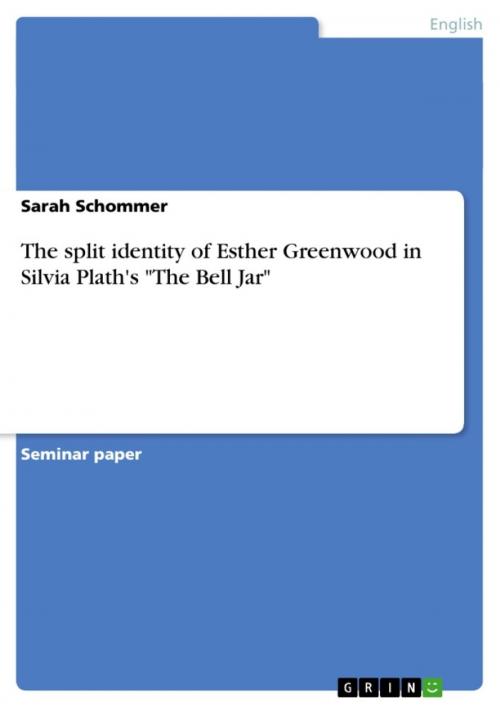The split identity of Esther Greenwood in Silvia Plath's 'The Bell Jar'
Fiction & Literature, Literary Theory & Criticism, British| Author: | Sarah Schommer | ISBN: | 9783640106578 |
| Publisher: | GRIN Verlag | Publication: | July 18, 2008 |
| Imprint: | GRIN Verlag | Language: | English |
| Author: | Sarah Schommer |
| ISBN: | 9783640106578 |
| Publisher: | GRIN Verlag |
| Publication: | July 18, 2008 |
| Imprint: | GRIN Verlag |
| Language: | English |
Seminar paper from the year 2008 in the subject English Language and Literature Studies - Literature, grade: 2,0, Johannes Gutenberg University Mainz (Department of English and Linguistics), course: Madness in Literature, 7 entries in the bibliography, language: English, abstract: 1.Introduction Madness is an important aspect in literature - especially madness of female writers respectively madness of female chief characters is interesting to deal with concerning the social role of women in the cause of time. It [madness] is that state of mind where a person's feelings or beliefs about himself [...] are completely disrupted, making him unable to function in whatever social role - husband, parent, friend, employee - he might expect to enjoy. It is the state where the sufferer passes beyond the bounds of reality, intelligibility, and rationality as defined by the bulk of society. The psychotic is a stranger among his own people. (Nettle 12) A character consistent to this definition of madness is Esther Greenwood in Silvia Plath's autobiographical novel The Bell Jar which was published 1963. Being a young intelligent woman, Esther becomes mad as a result of the mental stress to conform to the traditional role of women or to break tradition. Esther Greenwood is passive and unable to be agent of her life. Never having learned how to develop herself as an independent individual, she is dependent on others and follows their ideals of a fulfilling life. She is torn between starting a family and starting a career. According to this, The Bell Jar reveals the difficulty of becoming an adult, by breaking tradition to be able to realize one's personal scheme of life. As Susan Bassnett points out, 'The Bell Jar is a novel about a suicide attempt that fails; but it is also a novel about a woman who learns how to live with herself and how to come to terms with the world, that world of destruction and horror [...]' (Bassnett 122). As the story of Esther Greenwood's madness is full of interesting symbols and motifs, it is unfortunately impossible to deal with the whole of them. Consequently this paper will focus on few aspects revealing the split identity of Esther Greenwood and show the process of her recovery as well. These basic motifs are: the fig-tree, the fake identity she builds up and the motif of the bell jar. They will be discussed in the context of Esther's mental illness...
Seminar paper from the year 2008 in the subject English Language and Literature Studies - Literature, grade: 2,0, Johannes Gutenberg University Mainz (Department of English and Linguistics), course: Madness in Literature, 7 entries in the bibliography, language: English, abstract: 1.Introduction Madness is an important aspect in literature - especially madness of female writers respectively madness of female chief characters is interesting to deal with concerning the social role of women in the cause of time. It [madness] is that state of mind where a person's feelings or beliefs about himself [...] are completely disrupted, making him unable to function in whatever social role - husband, parent, friend, employee - he might expect to enjoy. It is the state where the sufferer passes beyond the bounds of reality, intelligibility, and rationality as defined by the bulk of society. The psychotic is a stranger among his own people. (Nettle 12) A character consistent to this definition of madness is Esther Greenwood in Silvia Plath's autobiographical novel The Bell Jar which was published 1963. Being a young intelligent woman, Esther becomes mad as a result of the mental stress to conform to the traditional role of women or to break tradition. Esther Greenwood is passive and unable to be agent of her life. Never having learned how to develop herself as an independent individual, she is dependent on others and follows their ideals of a fulfilling life. She is torn between starting a family and starting a career. According to this, The Bell Jar reveals the difficulty of becoming an adult, by breaking tradition to be able to realize one's personal scheme of life. As Susan Bassnett points out, 'The Bell Jar is a novel about a suicide attempt that fails; but it is also a novel about a woman who learns how to live with herself and how to come to terms with the world, that world of destruction and horror [...]' (Bassnett 122). As the story of Esther Greenwood's madness is full of interesting symbols and motifs, it is unfortunately impossible to deal with the whole of them. Consequently this paper will focus on few aspects revealing the split identity of Esther Greenwood and show the process of her recovery as well. These basic motifs are: the fig-tree, the fake identity she builds up and the motif of the bell jar. They will be discussed in the context of Esther's mental illness...















